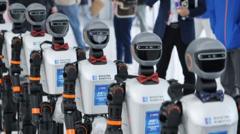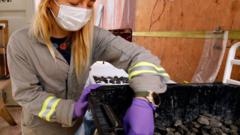As the demand for humanoid robots grows, multiple companies are racing to develop valuable and adaptable machines. The spotlight currently shines on the Unitree G1, showcased at Hannover Messe, which impresses with its size, affordability, and engaging capabilities. However, substantial hurdles remain before these robots can become commonplace in homes or restaurants.
The Race to Develop Humanoid Robots Heats Up

The Race to Develop Humanoid Robots Heats Up
Innovative robots emerge as companies vie for dominance in humanoid robotics.
The Chinese robotics sector stands out due to its supply chain advantages and significant investments. Major players like Tesla and Hyundai are also investing in humanoid robots but face competition from Asian manufacturers. With a focus on pragmatic design and cost-effectiveness, new entrants like Kinisi are crafting specialized robots for factories while eyeing the broader potential of humanoid companions for everyday tasks, though experts anticipate it may be years before they become ubiquitous.
---
A bright spring morning in Hanover, Germany witnesses the unveiling of the Unitree G1, a humanoid robot captivating attendees at the Hannover Messe, a premier industrial exhibition. Standing at just 4'3" (130cm), this robot, introduced by Chinese company Unitree, emerges as a smaller and more economical alternative to its larger counterparts, boasting impressive agility that has set social media abuzz with videos of its dance moves and martial arts finesse.
Pedro Zheng, Unitree's sales manager, demonstrates the G1, which is controlled remotely and requires programming for autonomous functions. Spectators are drawn to the G1, engaging in playful interactions, a welcome contrast to other machines that provoke less enthusiasm. The humanoid design of the G1 appears to foster a sense of comfort among onlookers, highlighting its built-in social potential.
Yet, the promise of humanoid robots extends well beyond mere entertainment; their integration into businesses could yield consistent labor without the complications of human employment. As home assistants, these robots could potentially tackle tasks like laundry and dishwashing. Nevertheless, deploying humanoid robots in unpredictable environments poses challenges, notably in their strength and the risks associated with falls.
A Unitree spokesperson notes that the necessary breakthroughs in artificial intelligence for effective control are still in the works, as current AI struggles with complex tasks. Presently, the G1 is targeted at research institutions and tech firms willing to explore its open-source software. While businesses hone in on humanoid applications for factory and warehouse use, highlighted by Tesla's development of the Optimus robot, the competition is intensifying.
Industry analysts track a wealth of companies in this domain, emphasizing how China appears well-poised to lead due to its thriving robotics ecosystem and the ease of research and development. Unitree’s $16,000 G1 underscores the affordability advantage enjoyed by Chinese manufacturers, who have captured nearly 60% of funding for humanoid robotics across Asia, aiming to play off government support.
How does this position U.S. and European companies in the race? For instance, Bristol-based entrepreneur Bren Pierce has launched Kinisi's KR1 robot, designed and engineered in the UK but manufactured in Asia to minimize costs. By opting for simpler designs tailored for factory use, Kinisi aims to avoid the complications of full humanoid robotics, instead equipping the KR1 without legs and relying on inexpensive, widely available parts.
The real competitive edge, according to Pierce, lies in user-friendly software that allows warehouse workers to operate the robots with minimal training. The ambitious vision of creating a fully functional "everything robot" is acknowledged but is still regarded as a long-term goal. Experts suggest that the dream of humanoid robots assimilating into everyday life may still be a decade away, despite the rapid advancements being made.
---
A bright spring morning in Hanover, Germany witnesses the unveiling of the Unitree G1, a humanoid robot captivating attendees at the Hannover Messe, a premier industrial exhibition. Standing at just 4'3" (130cm), this robot, introduced by Chinese company Unitree, emerges as a smaller and more economical alternative to its larger counterparts, boasting impressive agility that has set social media abuzz with videos of its dance moves and martial arts finesse.
Pedro Zheng, Unitree's sales manager, demonstrates the G1, which is controlled remotely and requires programming for autonomous functions. Spectators are drawn to the G1, engaging in playful interactions, a welcome contrast to other machines that provoke less enthusiasm. The humanoid design of the G1 appears to foster a sense of comfort among onlookers, highlighting its built-in social potential.
Yet, the promise of humanoid robots extends well beyond mere entertainment; their integration into businesses could yield consistent labor without the complications of human employment. As home assistants, these robots could potentially tackle tasks like laundry and dishwashing. Nevertheless, deploying humanoid robots in unpredictable environments poses challenges, notably in their strength and the risks associated with falls.
A Unitree spokesperson notes that the necessary breakthroughs in artificial intelligence for effective control are still in the works, as current AI struggles with complex tasks. Presently, the G1 is targeted at research institutions and tech firms willing to explore its open-source software. While businesses hone in on humanoid applications for factory and warehouse use, highlighted by Tesla's development of the Optimus robot, the competition is intensifying.
Industry analysts track a wealth of companies in this domain, emphasizing how China appears well-poised to lead due to its thriving robotics ecosystem and the ease of research and development. Unitree’s $16,000 G1 underscores the affordability advantage enjoyed by Chinese manufacturers, who have captured nearly 60% of funding for humanoid robotics across Asia, aiming to play off government support.
How does this position U.S. and European companies in the race? For instance, Bristol-based entrepreneur Bren Pierce has launched Kinisi's KR1 robot, designed and engineered in the UK but manufactured in Asia to minimize costs. By opting for simpler designs tailored for factory use, Kinisi aims to avoid the complications of full humanoid robotics, instead equipping the KR1 without legs and relying on inexpensive, widely available parts.
The real competitive edge, according to Pierce, lies in user-friendly software that allows warehouse workers to operate the robots with minimal training. The ambitious vision of creating a fully functional "everything robot" is acknowledged but is still regarded as a long-term goal. Experts suggest that the dream of humanoid robots assimilating into everyday life may still be a decade away, despite the rapid advancements being made.



















